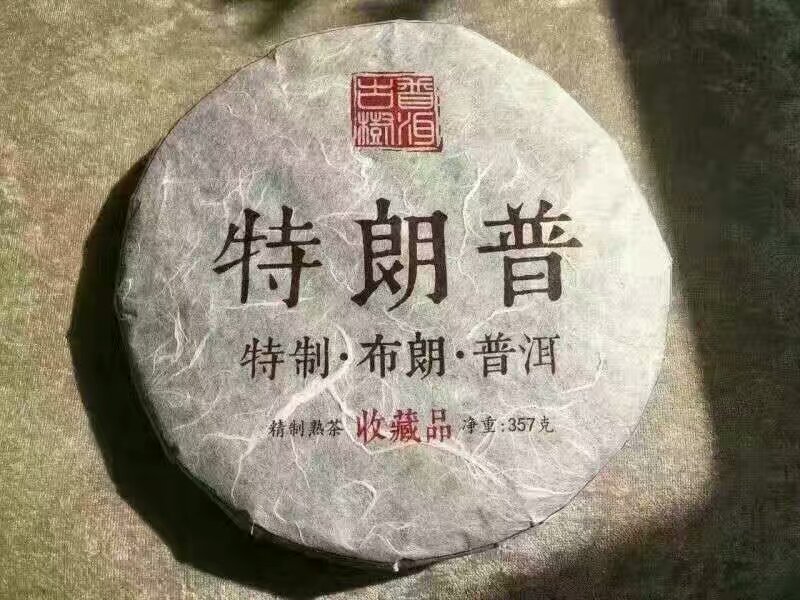Trump tea
« previous post | next post »
A friend of mine who does research on the history of tea in China recently shared the following photo in a WeChat group that focuses on Chinese food culture:
Here is a complete translation of all the writing on the wrapper:
[red seal at the top]
Pǔ'ěr gǔshù
普洱古樹
Pu'er ancient tree
Note: Pu'er / Pu-erh is a type of fermented tea produced in Yunnan province. During the first decade of this century, it became very fashionable and in some cases extremely expensive. Most domesticated, commercially marketed tea grows on waist-high bushes (convenient for harvesting!), but the tea plant (Camellia thea / Camellia sinensis) in the wild in its original homeland (roughly northeast Assam, northeast Burma, southernmost Yunnan, and northwest Laos) takes the form of a tree that may grow up to several tens of feet in height. Some tea trees are hundreds of years old, and leaves from such old trees are especially prized. I have some in my cupboard right now, and I parcel it out like gold, drinking one cup every two months or so.
Tèlǎngpǔ
特朗普
Trump
Note: Language Log discussions of Chinese transcriptions for Trump's surname may be found here and here.
tèzhì ‧ Bùlǎng ‧ Pǔ'ěr
特制 ‧ 布朗 ‧ 普洱
special ‧ Bulang ‧ Pu'er
Note: Bùlǎng 布朗 is the Chinese transcription of "Blang", which is the name of an ethnic group in southern Yunnan and the language they speak (related to Wa). The Blang and the Wa are Mon-Khmer speakers who have the deepest and most intimate relationship to the tea plant, its name, and its usage (See Victor Mair and Erling Hoh, The True History of Tea, Appendix C). The first character of the first word, the second character of the second word, and the first character of the third word form the Chinese transcription of the name "Trump".
jīngzhì shúchá
精制熟茶
fine fermented tea
shōucáng pǐn
收藏品
collector's item
Note: This product was packaged in November, 2016 or later, so the stocks of pu'er tea they used must have begun the fermentation process long before that (ten years, to be more precise [see the article cited below]).
jìngzhòng 357 kè
净重 357 克
net weight 357 grams
Within this article (in Chinese) there is a brief description of the tea and how the tea merchants have been promoting it. Incidentally, it sells for 750 yuan (US$108).
[Thanks to Matt Anderson, Daan Pan, and Jichang Lulu]

Lew Perin said,
January 14, 2017 @ 8:28 am
I was surprised to see that Trump transliteration. The one I see in the New York Sinosphere is 川普.
Victor Mair said,
January 14, 2017 @ 8:45 am
@Lew Perin
Transcription.
The links in the o.p. deal with the various Chinese character transcriptions of the name "Trump".
Jichang Lulu said,
January 14, 2017 @ 10:01 am
The sohu.com post linked in the article has (mostly humorous) names for the constituencies each tea could suit best (such as wùshípài 务实派 'pragmatists/the down-to-earth', nǚshì 女士 'ladies' – that one maybe not so humorous). For the Trump tea, the title is dòubī 逗逼, new-ish (Internet) slang made up of bī 屄/B/逼/比/… 'the pudendum muliebre' (a morpheme Victor has written plenty about) modified by dòu, here an adjective with protean semantics. 'Cute', 'silly', 'funny', in an affectionate way. I think the meaning would be close to fàn'èr 犯二, literally 'guilty of dumbth'.
That in turn contains èr 二 meaning 'silly', a usage that comes from northern topolect(s) and I've always found quite interesting. I wonder if it's related to the meaning 'two', if it's a lenition created within some word containing unstressed shǎ 傻 (or something else with a retroflex), or if we're just dealing with a topolectal morpheme without a known equivalent in the written standard (本字).
A fine word containing this èr is èrguòtóu 二过头, which I take as a double pun on e.g. cōngmingguòtóu 聪明过头 'too clever by half/too smart for your own good' and èrguōtóu 二锅头, a type of baijiu ((Chinese) distilled spirit).
As for the tea, when I first saw the picture I thought it was a joke or hoax, as the wrapping is quite different from the less fancy pu-erh cakes I'm used to seeing (this one is being marketed by a tea-lover circle 茶友会, not sold in shops). At first I assumed it was photoshopped.
Edwin Schmitt said,
January 14, 2017 @ 1:36 pm
One quick point, the 布朗 here is not necessarily referencing the 布朗族. As the sohu.com article also mentions it is referring to 特制.布朗山.普洱茶, where 布朗山 is a place name. Of course the 布朗族 are the primary residents of 布朗山, so there's nothing inherently wrong with the post as it is.
http://baike.baidu.com/view/5746270.htm
But the name of the tea is referencing the location of the tea's production. In fact this is a very common way to market tea.
Level of Quality/Location of Production/Type of Tea
These are all common elements within a tea marketing scheme and occasionally are integrated into the name. I think that is what will make the product all the more attractive to customers. So far in the tea circles I am connected to I have not heard that this picture is a joke or photoshopped.
nikeqiang said,
January 16, 2017 @ 10:32 am
Great post!
Check out qinglish.io for a fun tool that lets you play with the phonetic transliteration of English names (like Trump, Obama, etc), as well as other English words and phrases!
nikeqiang said,
January 16, 2017 @ 10:33 am
link should be qinglish.io!